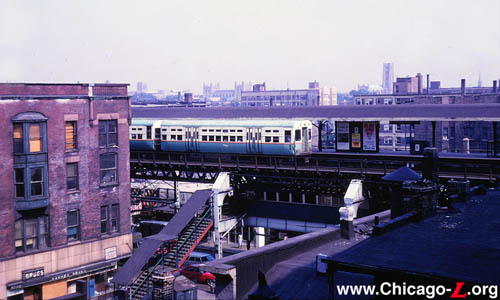
An outbound Jackson Park "B" train, led by car 6373, pulls into Dorchester station on June 24, 1966. Dorchester's layout was different than other Jackson Park branch stations, with its island platform and mezzanine station. Both are visible here. Note the East 63rd Street commercial district below the "L" and skyline in the background dominated by University of Chicago buildings. For a larger view, click here.
(Photo from the Graham Garfield
Collection)
|
Dorchester
(1400E/6300S)
Dorchester Avenue and 63rd
Street, Woodlawn
Service
Notes:

|
North-South
Route, Jackson Park branch
|

|
Accessible
Station (new
station, never completed)
|

|
Transfer to
Metra: Electric District
(new
station, never completed)
|
Quick Facts:
Address: 1400 E. 63rd
Street
Established: April 23, 1893
Original Line: South Side Rapid Transit
Previous Names: Madison Avenue
|
Skip-Stop Type:
|

|
Station
|
Rebuilt: 1994 (work suspended, never completed)
Status: Demolished
History:
Dorchester, originally called Madison Avenue, opened April 23,
1893 as part of the South Side Rapid Transit's extension from
39th Street to Jackson Park for the World's
Columbian Exposition. Service to Jackson Park (and the fair) didn't
start until May 12, so in the interim, passengers disembarked at
Madison and walked on a special walkway constructed on the "L"
structure.
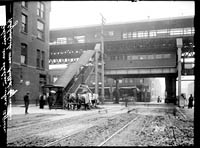
Dorchester station is seen looking north in 1906, largely appearing as it was built just over a decade earlier. The station had only two stairways from the street to its mezzanine-level station house slung over the intersection. A stairway then led up to the island platform. For a larger view, click here [off-site link]. (DN-0004212, Chicago Daily News negatives collection, Chicago History Museum, courtesy of the Library of Congress)
|
Dorchester was an unusual station and differed from its East
63rd Street companions in many ways. First, whereas all other
Jackson Park
branch stations had side platforms, Dorchester had an island
platform. The structure above 63rd Street had a center track (used for
storage), which ended just west of the station; the platform was
located in this center space. Just east of the platform, the
structure narrowed and the two tracks came side-by-side to cross the
Illinois Central Railroad tracks. Just beyond the bridge over the ICRR was a crossover,
then the Jackson Park (Stony
Island) station.
Additionally, whereas the other Jackson Park branch stations (originally) had two platform-level station houses -- one on each side, for each direction --
Dorchester was the only Jackson
Park station to have a mezzanine-level facility below the
tracks, over 63rd Street. The exterior design of this mezzanine was simple and largely unadorned. The interior of the station house had wood-paneled walls and wooden floors. There was a ticket agent's booth and iron railings for fare control. A potbelly stove provided heat in the winter and washrooms were available for passenger use. The island platform was simple and had a "humpback" or "turtleback" canopy, which was characteristic of other South Side Rapid Transit stations built for the Jackson Park extension.
Beginning in 1919, trains of the Chicago North Shore &
Milwaukee interurban railroad began to operate into the Loop via the
tracks of the North Side "L". Beginning in 1922, some trains
continued south to Dorchester, operating its Merchandise Dispatch
from the 63rd Street
Lower Yard. (Numerous other transit connections could be made at
Dorchester, including to the Chicago Lake Shore & South Bend
Railroad; electric cars to Windsor Park, South Chicago and South
Deering; and trains of the Illinois Central Railroad.) As for why the
CNS&M trains didn't continue to the end of the line (only one
station east),
The trains had to go beyond Dorchester
(the next-to-last station) to come back on the other track,
perhaps going up to the Jackson
Park platform "on top" of a short "L"
train and changing ends quickly.
If Jackson
Park had been listed as a North Shore
station, the trains would have had to go all the way to the end of
the track and stand for a while to load or unload. Maybe that
would have unduly obstructed the frequent Jackson Park Express "L"
trains.1
Basically, ending at Dorchester prevented them from getting in the
way of the "L". North Shore Line service to Dorchester ceased in 1938
when the service was cut back to Roosevelt.
Dorchester's history after the CTA took over operation of the "L" in 1947 was unremarkable. The station was little modified over the years. Passenger traffic began to decrease dramatically in the late 1960s. The station was closed on January 13, 1973 in one of the several rounds of cost-cutting that year that included multiple station closures and service reductions. It was most likely torn down shortly thereafter.
Despite the lack of a station facility there, Dorchester came back
into the public eye on March 4, 1982, when service on the Jackson
Park branch was suspended south of 61st
Street due to structural defects in the bridge over
the Illinois Central Railroad, which was located immediately east of where the Dorchester station had been. On December 12, 1982, service was
restored as far as the University stop.
The defective bridge was demolished in 1987.
A New Station for Dorchester?
|
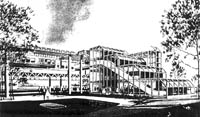
The proposed Dorchester terminal station is shown in an artist's rendering. For a larger view, click here. (Drawing from Graham Garfield Collection)
|
After service was resumed only as far as University, west of the Illinois Central embankment and the defective Dorchester Bridge, talk abounded of re-extending the Jackson
Park branch to Dorchester and building a new terminal there.
Mayor Jane Byrne announced a
four-point program in 1982 that included a new Jackson
Park branch terminal at Dorchester, providing a direct connection to
the Illinois Central commuter line and a
CTA bus terminal for intermodal transfers.
The plan proceeded, with design work undertaken in the 1980s on the elevated track structure and terminal station. The station would have included a glass and steel station house with elevators and escalators, as well as facilities for trainmen. The station would have had an island platform with a full-width canopy covering the platform and tracks supported by columns outside the tracks.
Construction work to build the extension from University to Dorchester began
in the 1990s. By 1994, when the Green Line (of which the Jackson Park branch had become part of the previous year) closed for renovation, the elevated track structure had been completed from University to Dorchester, and some of the steel for the station platform and canopy columns had been erected. In addition, maps began to list Dorchester as the
terminus of the line, anticipating the new terminal facility that was to be completed by the time the Green Line renovation was completed. This facility, however, was never
finished. Instead, the Dorchester extension (and indeed the rest of the East 63rd branch, as the Jackson Park branch was now called) became a point of contention within the local Woodlawn community, with some residents advocating for the improved transportation and economic development stimulus that the "L" provided, while other residents led by local pastor Reverend Arthur Brazier believed the
structure over East 63rd Street would further blight Woodlawn and
prevent redevelopment.
The latter group won out and when the Green Line reentered service in May 1996, Cottage Grove became the end of the line. As a result, the
CTA gave up millions of
federal dollars invested in the project and rapid transit service was
withdrawn from much of the Woodlawn community. University station was closed. The Dorchester station was never used and the tracks east of Cottage Grove station, including University station and the track and partial station structure for the Dorchester extension, were demolished in September 1997, with the CTA forfeiting the federal grant funds they'd received to build the extension and intermodal facility.
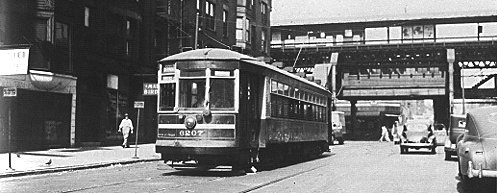
Chicago Surface Lines car 6207 travels south, just beyond 63rd Street, having passed under the Dorchester Avenue "L" station. (Photo from the Barney Neuberger Collection) |

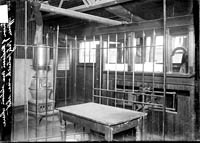 |
n004211.jpg (98k) [Off-site link]
The interior of the Madison Avenue (later renamed Dorchester Avenue) "L" station is seen in 1906. Note the wooden ticket agent's booth, iron railings and gates for fare control, and potbelly stove for winter heating. The turnstile, typical of early designs for rapid transit stations made of arms of pipes or tubing that rotated horizontally, was probably not original; the crude opening in the agent's booth suggests it was added later. (DN-0004211, Chicago Daily News negatives collection, Chicago History Museum, courtesy of the Library of Congress) |

|
dorchester-P-8_50sSignNB.jpg (85k)
This "symbol sign", as CTA calls them, from the northbound side of Dorchester island platform is of a type implemented beginning in the mid-1950s. The artwork for this sign from the CTA Staff Engineer's Office is dated November 8, 1960; the signs were likely fabricated and installed not long after. The design of this sign, for the northbound direction toward downtown and Howard, is typical of this type: large first letter of the station name with the full name under it; the skip-stop letter on a color-coded band (green used for 'B' stations on through-routed services) in the middle; and an arrow pointing in the direction of travel with the direction and destination. The companion sign on the southbound side was much simpler and lacked many of these details -- it had had no skip-stop band, arrow or direction, only a "D Dorchester" on a white plate -- presumably because, as the penultimate stop just a few blocks from the terminal -- it was assumed few people were actually boarding there in the southbound direction, so the information primarily for boarding passengers was omitted. (Sign courtesy of Bill Wulfert) |

1"Shop Track" First and Fastest.
Vol. X, No. 3 (Autumn 1994), 14.








